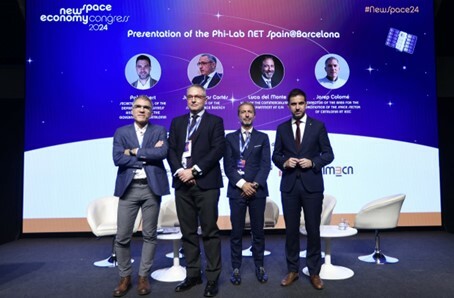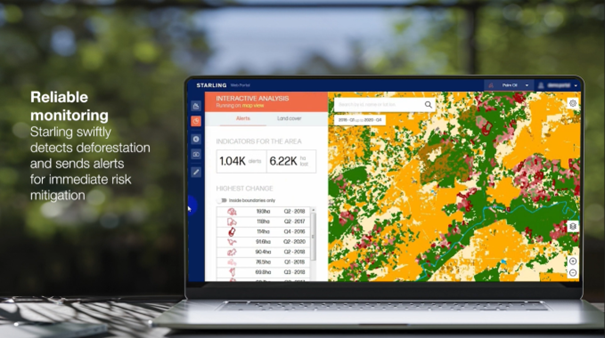Satellite Applications for Climate Change: Insights from the New Space Economy Congress 2024

The fifth edition of the New Space Economy Congress 2024, the now annual event for the growing Catalonian new-space ecosystem, took place in Barcelona from 1-2 October. Organised by the Chamber of Commerce and the Government of Catalonia, was supported by several main partners: the Institute of Space Studies of Catalonia (IEEC), the i2CAT Foundation, the Cartographic and Geological Institute of Catalonia (ICGC) and KIMbcn Foundation. The event aimed to promote Catalonian new space companies, and foster cooperation, collaboration, and innovation across and beyond the region. Amidst two days of discussions and demonstrations ranging deep-sea exploration to future commercial space stations, the growing array of satellite communications constellations, the regulatory considerations to ensure the sustainable use of space, and regional challenges and opportunities for new space companies, Eurisy was present to lead discussions on a session on satellite applications for climate change challenges.
At the end of day one, one conclusion was apparent: Europe must be bolder and braver in enabling the development of space technologies, upstream and downstream, and work harder to connect the benefits of space technologies with new business sectors and society as a whole. The European Commission is leading this effort with a number of initiatives highlighted during an opening keynote by Catherine Kavvada, Director of Secure and Connected Space at DG DEFIS, within the context of a growing recognition of the importance of space within the proposed commission. The Commission approach is based on three main pillars: supporting entrepreneurs through initiatives like CASSINI; enabling transferability by promoting international, interinstitutional, and commercial cooperation; and fostering business-friendly procurement schemes, particularly for SMEs, with the Commission acting as a consistent anchor customer. These pillars aim to develop and strengthen the competitiveness of the European space ecosystem.
ESA is also developing a range of activities supporting competitiveness and innovation in the European space ecosystem. Announced during the congress by Luca del Monte, Head of the Commercialisation Department at ESA, was the launch of the Spain Barcelona Phi-Lab, the third launched within the Phi-Lab NET, a network of Phi-Labs across ESA member states supporting the development of highly innovative, disruptive, EO-based technologies. The Phi-Lab Net was proving an increasingly important and successful component of ESA’s commercialisation approach, according to Mr. del Monte, with 11 further Phi-Labs set to launch by the end of 2024.

From left to right: Josep Colomé (IEEC), Juan Carlos Cortés (Spanish Space Agency (AEE)), Luca del Monte (ESA), Pol Gibert (Generalitat de Catalunya). Image credit: Generalitat de Catalunya.
Day two focused on satellite applications, in particular for water management and sustainability, and was opened with Cristina Giannopapa, Head of the Office of the Executive Director at the European Union Agency for the Space Programme (EUSPA) introducing the world-leading capabilities provided by the EU Space Programme, including the Copernicus programme for Earth Observation and Galileo, the world’s most accurate satellite navigation constellation. The impact of space applications on tackling societal challenges and enabling new business opportunities is significant but should not be overstated, according to Ms Giannopapa. Space must certainly be part of solutions, by supporting decision and policymakers, business, and citizens, in particular supporting sustainability, however, it should be incorporated with other forms of data and models. The Copernicus programme, for example, includes data sources not only from space, but also from the air and Earth surface, making it a more complete, reliable, and effective system.
Focusing on how space can contribute to climate change, Annalisa Donati, Secretary General of Eurisy, moderated a panel on the topic including representatives from Telespazio Iberica, Airbus, the French Prime Minister’s Office, and the Cartographic and Geological Institute of Catalonia (ICGC). Beginning with a use case demonstration on how Copernicus data helps relieve urban heat islands, Ms Donati reiterated the point that the space sector should keep in mind that the end user does not necessarily know or care about the kind of data they are receiving, but what matters far more is to deliver on their need for these kind of services that space data can enable. Eurisy has worked for over 30 years to centre user perspectives, better understanding their needs to connect them with relevant satellite applications.
Satellite applications offer a range of powerful tools highlighted by the panellists in tackling climate change. One such application was provided by Anna Tardà, Operational Manager of Hyperspectral Sensors at ICGC. In the mountainous forests in the north of Catalonia, the local authorities had been facing a severe drought, placing a large strain on the nature and communities there. Understanding precisely where and to what extent the drought was impacting the forests was proving difficult, however, as few accessible roads are available, and to fully understand what damage had been caused, it would be necessary to observe the forest canopy from above. By using Sentinel-2 data over time to create a time series map of the vegetation index, the ICGC helped the local authorities understand exactly which areas were facing greater strain than others, allowing them to target their activities more efficiently and effectively.
The panellists agreed that the focus should be on engaging with agents of change, such as public authorities, more effectively, in order to ensure satellite applications, meet their needs and inform them sufficiently to initiate actions to tackle or mitigate climate change. Satellite applications should not be based simply on the desire to develop technologies without considering first what is the specific use case being addressed. This requires an intense and continuous engagement with potential users to understand the problem context where research & development should take place within. One approach highlighted was through Public Private Partnerships, which enables a more direct connection between the needs of public authorities and the development and provision of targeted services. This approach takes place differently at different levels, according to François Spiero, Manager of European Space Affairs at the French Prime Minister’s Office and Professor at the International Space University, who also noted that the national provision of funding tends to encourage greater risk than at European or international in attempting to foster innovation and disruptive solutions.

Starling service developed by Airbus in cooperation with Earthworm to monitor deforestation. Image credit: Airbus
One challenge highlighted in developing new, innovative technologies, however, was that within Europe the regulatory environment could be too slow to react. A prohibitive environment, in which new technologies could be stymied by having to wait for a protracted reform or approval process, prevents companies from bringing new technologies to market, harming European competitiveness, and denying users access to potentially beneficial solutions. Regulation could also play a positive role, by directing activities into productive and beneficial avenues for addressing societal challenges. One such example was provided by Roser Roca, Managing Director & CEO at Airbus GeoTech, regarding their partnership with NGOs and private companies to tackle deforestation. In this case, the cooperation is initiated by the regulatory need under the EU Deforestation Regulation (EUDR) for companies wishing to import certain products into the European Union to conduct due diligence that their supply chain is free of deforestation. To support this, Airbus have been cooperating with Earthworm, an NGO working on sustainable supply chains, to work with companies to run time series maps on companies’ plots, comparing changes to identify where deforestation has taken place.
Ultimately, the panel agreed a balance is needed between technological regulation to support businesses and regulations launching initiatives which answer societal challenges. Supporting technological development for solutions for sustainability means such services themselves should be sustainable, and therefore a greater focus should be on moving beyond technology demonstrations and working with public authorities to increase adoption. Fundamentally, public authorities, and most end users in general, neither know nor care whether their solution results from satellite data or not. As Joaquim Bellvert, Researcher of the Efficient Use of Water in Agriculture Program at IRTA concluded during a panel on Integrating Space into Water Management, from their perspective as an operational user what mattered was that it solved a problem, and as such the solution, from being a novelty, becomes a commodity.
